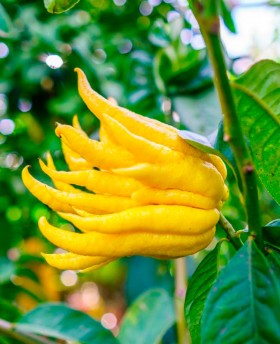





Buddha’s Hand (Citrus Medica Sarcodactylis)
Grows as a shrub or small tree. Native to India and China. Its fruit, shaped like a hand, is highly aromatic.
According to Buddhists, it resembles intertwined hands in prayer, and is used as an offering in their temples.
It ripens from September to March. It belongs to the citrus family, like oranges and lemons. Its peel is used for its aromatic properties to flavor food, as a cocktail air freshener, or it can be eaten raw…
Pot: 45–50 liters. Total height: 1.7–1.8 m
 Shipments to Spain and Portugal ...
Shipments to Spain and Portugal ...
The cost of transportation depends on the province or country.
Buddha’s Hand (Citrus Medica Sarcodactylis)
ORIGIN AND CHARACTERISTICS
Citrus trees, commonly called "citrics" or "sour fruits," belong to the botanical genus Citrus and the Rutaceae family. Their fruits are rich in vitamin C and citric acid. They originate from tropical and subtropical Asia.
Citrus plants are small trees or shrubs, growing between 5 and 8 m. For cultivation, pruning is recommended to keep them from growing too tall and to ease harvesting. Some have thorns. They have dense foliage and evergreen leaves. These trees are long-lived and sensitive to cold temperatures below -4°C.
Flowering occurs in spring (April–May) and again in autumn. The latter bloom is more fragrant. Essential oils can be extracted from all parts of the plant (branches, leaves, flowers, fruits, and seeds), though they are mainly grown for their fruit.
DECORATION – OUTDOORS OR INDOORS?
Lemon trees are suitable for gardens or orchards and can grow quite tall. It's best to prune them before flowering to encourage new shoots and keep them at a manageable height for harvesting, ideally around 3 m.
If grown indoors, place them in very bright areas. In pots, they remain smaller and won’t grow as much…
CARE
• Needs plenty of water and sunlight. It must be very well lit. It can tolerate down to -4°C. In colder weather, cover with a tarp.
• Prune before spring to remove dry branches and stimulate stronger new growth.
• Feed with fertilizers rich in nitrogen, phosphorus, and potassium. Worm humus is also beneficial. Fertilize in spring, summer, and autumn.
• Water generously: every three days in winter and more frequently in summer.
• Good drainage is essential, both in soil and in pots.
Specific References
You might also like